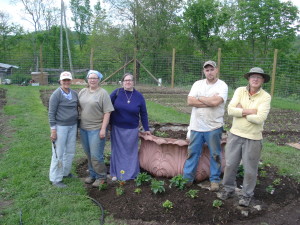From the New Vrindaban Garden: Companion Plants 5-19-14
This week in the garden the weather has shown us just how unpredictable May weather can be, in a few days we went from over 80 degrees to a light frost. Many of our more sensitive plants were covered the last two nights. If you are unable to cover your plants at night often they can be saved by heavily watering the foliage before the sun has a chance to melt the frost off of the plants. This is what we did in both the Teaching Garden and the Garden of Seven Gates.
In the Garden of Seven Gates we have been working on a large bed of 300 tomatoes and 200 peppers. Within this bed we are doing companion planting. Companion planting is defined as the close planting of different plants that enhance each other’s growth or protect each other from pests. A great historical example of companion planting is “the three sisters”. According to Iroquois legend, corn, beans, and squash are three inseparable sisters who only grow and thrive together. This tradition of interplanting corn, beans and squash in the same mounds, widespread among Native American farming societies, is a sophisticated, sustainable system that provided long-term soil fertility and a healthy diet to generations.
With our tomatoes and peppers we are also planting basil, rosemary, and marigolds. This will help to deter pests and provide beautiful flowers for the temple. In the teaching garden you will find beds that have flowers intermixed with lettuce and spinach. The following link is a great site for finding basic companion plants http://www.ghorganics.com/page2.html . I hope everyone has a wonderful sunny week in the garden.



